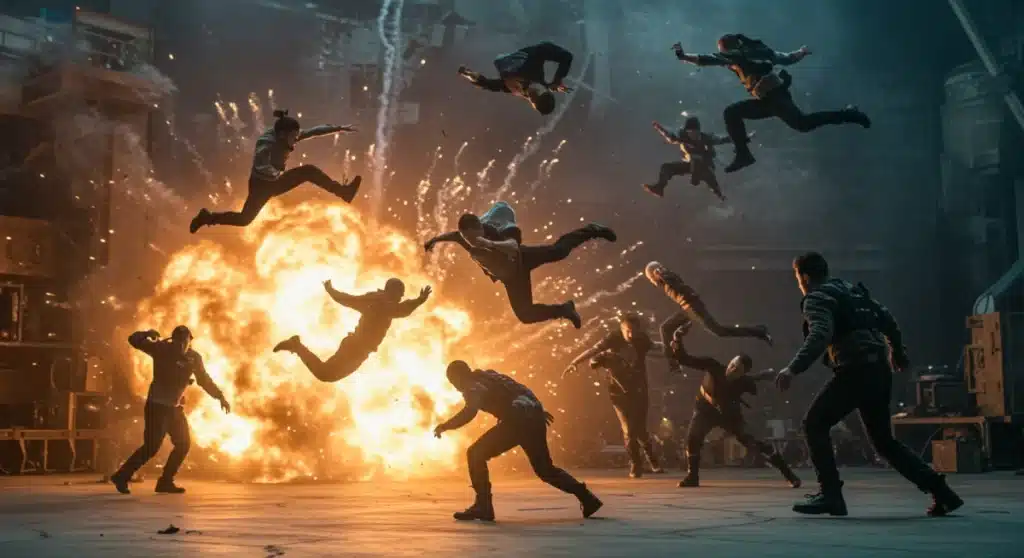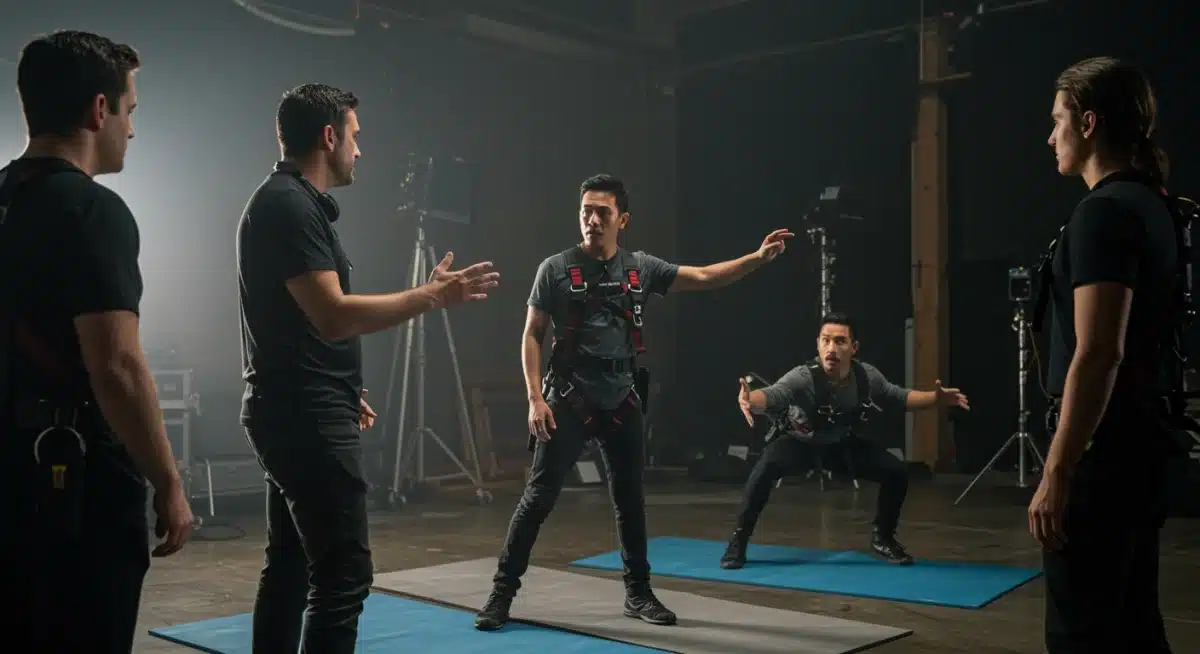Decoding Stunt Choreography: 4 Key Techniques in Prime Video Films

Recent Prime Video productions are utilizing sophisticated stunt choreography, employing four core techniques to enhance realism and spectacle in their action sequences, setting new industry benchmarks for thrilling cinematic experiences.
Decoding the Stunt Choreography: How 4 Key Techniques Elevated Action Sequences in Recent Prime Video Films is currently a hot topic in the entertainment industry as viewers and critics alike observe a noticeable surge in the quality and complexity of action sequences. These advancements are not accidental; they are the result of meticulous planning and the application of innovative techniques behind the scenes.
The Rise of Pre-Visualization and Digital Planning
Prime Video’s recent action blockbusters owe much of their visceral impact to advanced pre-visualization techniques. This crucial stage allows filmmakers to meticulously plan every beat of a stunt sequence long before cameras roll, integrating digital models and virtual environments to refine choreography and camera angles. This approach minimizes on-set risks and maximizes creative potential, ensuring that every punch, kick, and explosion serves the narrative.
The process often begins with animatics, crude animated storyboards that provide a basic understanding of timing and movement. These evolve into more sophisticated pre-visualization (pre-vis) sequences, which are essentially rough computer-generated versions of the final action, complete with character models and environmental details. This digital sandbox allows stunt coordinators and directors to experiment freely, identifying potential issues and optimizing the flow of action without the time and cost pressures of a physical set.
Virtual Reality Integration in Stunt Design
A significant development in recent months, as reported by various industry outlets, is the increased use of virtual reality (VR) in pre-visualization. Stunt teams are now able to ‘walk through’ and ‘perform’ sequences in a virtual environment, gaining a much deeper understanding of spatial dynamics and potential hazards.
- Enhanced Spatial Awareness: VR allows stunt performers to visualize complex environments and movements in a 3D space, improving their understanding of the choreography.
- Early Problem Identification: Issues with sightlines, camera placement, or performer safety can be identified and corrected in the virtual realm, saving valuable production time.
- Creative Iteration: Directors and choreographers can rapidly iterate on different versions of a stunt, testing variations in speed, impact, and character interaction.
Advanced Wirework and Rigging Systems
The days of visibly clunky wire rigs are largely behind us, thanks to innovations in wirework and rigging systems that have been prominently featured in Prime Video’s latest action offerings. Modern systems are lighter, stronger, and more discreet, allowing for breathtaking aerial maneuvers and dynamic fight sequences that appear seamless to the audience. These advancements are critical for achieving the fluidity and realism demanded by contemporary viewers.
Specialized rigging teams work closely with stunt choreographers to design bespoke systems for each sequence. This often involves a combination of high-strength aircraft cables, sophisticated pulley systems, and computer-controlled winches that can precisely manipulate performers’ movements. The goal is to create the illusion of effortless motion, whether it’s a character soaring through the air or executing an impossible flip.
Motion Control and Computer-Assisted Rigging
As of late, the integration of motion control technology with traditional rigging has become a game-changer. This allows for repeatable, precise movements that are essential for complex stunts involving multiple elements or interactions with digital effects.
- Precision and Repeatability: Motion control systems ensure that complex wirework maneuvers can be executed identically across multiple takes, vital for seamless editing and visual effects integration.
- Dynamic Camera Integration: These systems can be synchronized with camera movements, allowing for incredibly dynamic shots that follow the action closely without human error.
- Enhanced Safety Protocols: Computer-controlled systems often include redundant safety features and real-time monitoring, significantly reducing the risk of accidents during high-stakes stunts.
Integration of Practical Effects with CGI
A hallmark of elevated action sequences in recent Prime Video productions is the masterful blending of practical effects with computer-generated imagery (CGI). This technique ensures that action feels grounded and tangible, while still allowing for the fantastical elements that CGI can provide. The goal is to make the audience question where reality ends and digital artistry begins, immersing them fully in the spectacle.
For instance, a car chase might involve real vehicles performing high-speed maneuvers, with CGI augmenting explosions or adding impossible environmental damage. This hybrid approach leverages the strengths of both mediums: the raw energy and weight of practical stunts, combined with the limitless possibilities of digital enhancement. Stunt performers often interact with practical elements on set, providing genuine reactions and physics that CGI can then build upon.
Seamless Blending Techniques
Recent developments show an increasing sophistication in how these two realms are combined. Visual effects artists are now able to precisely match lighting, texture, and physics between practical and digital elements, making the transitions virtually undetectable.
A complex fight scene, for example, might feature a stunt performer executing a series of impressive practical moves, with a digital double seamlessly taking over for a dangerous fall or an interaction with a CGI creature. This level of integration requires close collaboration between the stunt department, special effects team, and visual effects artists from the earliest stages of production.

Martial Arts and Parkour Specialization
The specificity and authenticity of hand-to-hand combat and physical movement have been significantly elevated in Prime Video’s recent films, largely due to the recruitment of highly specialized martial arts and parkour practitioners. These experts bring a level of realism and fluidity to fight choreography that traditional stunt work often lacks, making each encounter feel more impactful and believable.
Instead of generalized stunt performers, productions are increasingly seeking individuals with deep backgrounds in specific disciplines like Wushu, Taekwondo, Krav Maga, or various forms of gymnastic parkour. This allows for a much richer vocabulary of movement, enabling choreographers to design sequences that are not only visually stunning but also reflect the character’s fighting style and background.
Character-Driven Combat Styles
A key trend observed, according to recent reports from stunt coordination guilds, is the development of unique combat styles for individual characters. This goes beyond generic action and delves into how a character’s personality, training, and motivations influence their fighting technique.
- Authentic Representation: Employing specialists ensures that the techniques displayed are genuinely representative of the martial art, adding to the film’s credibility.
- Dynamic Movement: Parkour elements introduce verticality and environmental interaction, transforming fight scenes into dynamic engagements with the surroundings.
- Storytelling Through Stunts: A character’s fighting style can reveal aspects of their past or personality, integrating action more deeply into the narrative.
Enhanced Safety Protocols and Training
While pushing the boundaries of action, Prime Video productions have also underscored a paramount commitment to safety. The complexity of modern stunt choreography necessitates rigorous safety protocols and continuous advanced training for all involved personnel. This includes not only the stunt performers but also the rigging crews, medical support, and directorial teams.
Every stunt sequence, regardless of its apparent simplicity, undergoes multiple layers of risk assessment. This involves detailed planning meetings, dry runs, and the use of specialized safety equipment such as airbags, crash mats, and harnesses. On-set medical teams are standard, ensuring immediate response capabilities for any incident, however minor.
Continuous Professional Development
The stunt industry is constantly evolving, and Prime Video’s partners are investing heavily in continuous professional development for their teams. This ensures that stunt performers and coordinators are not only proficient in current techniques but are also trained in emerging technologies and safety practices.
Recent initiatives, as highlighted by various industry safety organizations, include workshops on new rigging systems, advanced combat choreography techniques, and psychological preparedness for high-pressure stunt execution. This proactive approach to training is crucial for maintaining a high standard of safety while executing increasingly ambitious action sequences.
The Impact of Global Stunt Talent Pools
The excellence seen in recent Prime Video action sequences is also a direct result of tapping into a diverse and globally connected pool of stunt talent. Filmmakers are no longer limited to local stunt rosters but are actively seeking out specialized performers and choreographers from around the world, bringing unique cultural fighting styles and innovative approaches to the screen.
This global recruitment strategy enriches the visual language of action, allowing for a broader spectrum of combat and movement styles to be incorporated. Whether it’s a specific acrobatic technique from Asian martial arts or a gritty, realistic close-quarters combat style developed in military training, these diverse influences contribute to more original and captivating action set pieces. The exchange of ideas and techniques across international borders fosters a competitive environment that pushes creative boundaries.
Cross-Cultural Choreographic Exchange
As reported by various international film commissions, the trend of cross-cultural collaboration in stunt choreography is accelerating. This involves bringing together choreographers and performers from different nations to fuse their expertise.
- Diverse Skill Sets: Access to a wider range of specialists, from traditional martial artists to extreme sports athletes, broadens the choreographic possibilities.
- Innovative Combinations: Blending different fighting styles and movement philosophies can lead to entirely new and exciting forms of on-screen action.
- Authenticity and Appeal: Incorporating globally recognized action elements can resonate with a wider international audience, enhancing the film’s global appeal.
| Key Technique | Brief Description |
|---|---|
| Pre-Visualization & Digital Planning | Meticulous digital planning, including VR, to refine choreography before filming, enhancing safety and creativity. |
| Advanced Wirework & Rigging | Lighter, stronger, and computer-controlled systems for seamless aerial maneuvers and dynamic fight sequences. |
| Practical Effects & CGI Integration | Masterful blending of practical stunts with CGI for grounded yet spectacular action, blurring the lines between real and digital. |
| Specialized Martial Arts & Parkour | Recruiting experts in specific disciplines for authentic, fluid, and character-driven combat styles. |
Frequently Asked Questions About Stunt Choreography
Pre-visualization (pre-vis) is the process of digitally planning and animating complex stunt sequences before filming. It allows directors and stunt coordinators to refine movements, camera angles, and timings in a virtual environment, enhancing both safety and creative execution.
Advanced wirework systems utilize lighter, stronger materials and computer-controlled winches for precise manipulation. This enables seamless aerial stunts and dynamic movements, making the action appear more fluid and realistic while significantly improving performer safety on set.
Combining practical effects with CGI creates a more grounded and immersive experience. Practical stunts provide real physics and performer reactions, which CGI then enhances with fantastical elements or amplifies impacts, resulting in action that feels both tangible and spectacular.
Specialized martial artists and parkour practitioners bring authentic, discipline-specific movements to fight choreography. This ensures realism, allows for unique character-driven combat styles, and introduces dynamic environmental interaction, elevating the overall quality and impact of action sequences.
Safety is paramount in modern stunt choreography. Rigorous risk assessments, advanced safety equipment, on-set medical teams, and continuous training are standard. These measures ensure that increasingly complex stunts can be executed with minimal risk to performers and crew, maintaining high production standards.
Looking Ahead
The ongoing evolution of stunt choreography, particularly evident in recent Prime Video films, signals a new era for action cinema. As technology continues to advance and global talent pools become more interconnected, audiences can anticipate even more breathtaking and immersive action sequences. This commitment to innovation not only elevates entertainment value but also pushes the boundaries of cinematic storytelling, solidifying Prime Video’s position as a leader in delivering high-octane content. The industry will undoubtedly watch closely for the next breakthroughs in this dynamic field.